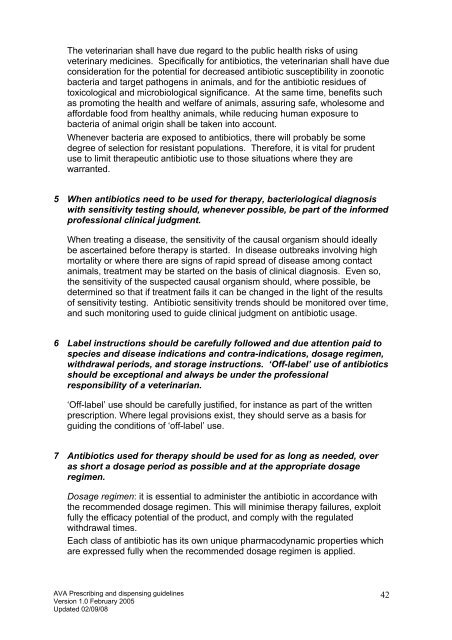Guidelines for Prescribing, Authorising and Dispensing - Australian ...
Guidelines for Prescribing, Authorising and Dispensing - Australian ...
Guidelines for Prescribing, Authorising and Dispensing - Australian ...
You also want an ePaper? Increase the reach of your titles
YUMPU automatically turns print PDFs into web optimized ePapers that Google loves.
The veterinarian shall have due regard to the public health risks of using<br />
veterinary medicines. Specifically <strong>for</strong> antibiotics, the veterinarian shall have due<br />
consideration <strong>for</strong> the potential <strong>for</strong> decreased antibiotic susceptibility in zoonotic<br />
bacteria <strong>and</strong> target pathogens in animals, <strong>and</strong> <strong>for</strong> the antibiotic residues of<br />
toxicological <strong>and</strong> microbiological significance. At the same time, benefits such<br />
as promoting the health <strong>and</strong> welfare of animals, assuring safe, wholesome <strong>and</strong><br />
af<strong>for</strong>dable food from healthy animals, while reducing human exposure to<br />
bacteria of animal origin shall be taken into account.<br />
Whenever bacteria are exposed to antibiotics, there will probably be some<br />
degree of selection <strong>for</strong> resistant populations. There<strong>for</strong>e, it is vital <strong>for</strong> prudent<br />
use to limit therapeutic antibiotic use to those situations where they are<br />
warranted.<br />
5 When antibiotics need to be used <strong>for</strong> therapy, bacteriological diagnosis<br />
with sensitivity testing should, whenever possible, be part of the in<strong>for</strong>med<br />
professional clinical judgment.<br />
When treating a disease, the sensitivity of the causal organism should ideally<br />
be ascertained be<strong>for</strong>e therapy is started. In disease outbreaks involving high<br />
mortality or where there are signs of rapid spread of disease among contact<br />
animals, treatment may be started on the basis of clinical diagnosis. Even so,<br />
the sensitivity of the suspected causal organism should, where possible, be<br />
determined so that if treatment fails it can be changed in the light of the results<br />
of sensitivity testing. Antibiotic sensitivity trends should be monitored over time,<br />
<strong>and</strong> such monitoring used to guide clinical judgment on antibiotic usage.<br />
6 Label instructions should be carefully followed <strong>and</strong> due attention paid to<br />
species <strong>and</strong> disease indications <strong>and</strong> contra-indications, dosage regimen,<br />
withdrawal periods, <strong>and</strong> storage instructions. ‘Off-label’ use of antibiotics<br />
should be exceptional <strong>and</strong> always be under the professional<br />
responsibility of a veterinarian.<br />
‘Off-label’ use should be carefully justified, <strong>for</strong> instance as part of the written<br />
prescription. Where legal provisions exist, they should serve as a basis <strong>for</strong><br />
guiding the conditions of ‘off-label’ use.<br />
7 Antibiotics used <strong>for</strong> therapy should be used <strong>for</strong> as long as needed, over<br />
as short a dosage period as possible <strong>and</strong> at the appropriate dosage<br />
regimen.<br />
Dosage regimen: it is essential to administer the antibiotic in accordance with<br />
the recommended dosage regimen. This will minimise therapy failures, exploit<br />
fully the efficacy potential of the product, <strong>and</strong> comply with the regulated<br />
withdrawal times.<br />
Each class of antibiotic has its own unique pharmacodynamic properties which<br />
are expressed fully when the recommended dosage regimen is applied.<br />
AVA <strong>Prescribing</strong> <strong>and</strong> dispensing guidelines<br />
Version 1.0 February 2005<br />
Updated 02/09/08<br />
42

















